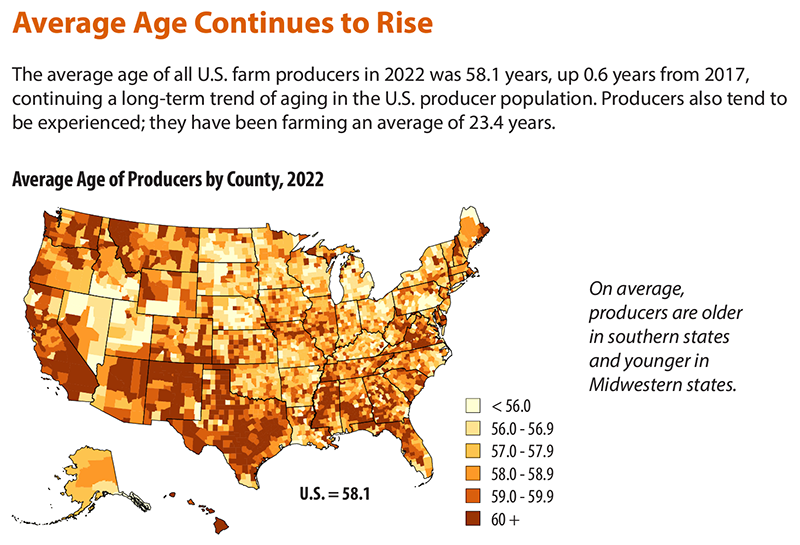Given our belief in the power and potential of regenerative agriculture to address many of the pressing issues of our times related to food, climate, biodiversity, and community,
Highlighting Trends in Ag and Finance: Aging farmers, acres in transition, and a call for $300B in capital

Map from 2022 Census of Agriculture Highlights, Farm Producers, USDA NASS, 2022 Census of Agriculture.
03/27/2024
By: Wendy Millet and Jessica Hartzell

 Given our belief in the power and potential of regenerative agriculture to address many of the pressing issues of our times related to food, climate, biodiversity, and community, understanding the state of farms, farmers, and the financial system that underpins the national and global food system are topics of great interest to us.
Given our belief in the power and potential of regenerative agriculture to address many of the pressing issues of our times related to food, climate, biodiversity, and community, understanding the state of farms, farmers, and the financial system that underpins the national and global food system are topics of great interest to us.
To that end, we wanted to highlight key trends in farm and ranch ownership in the US and a new report about the financial resources needed to facilitate large-scale transition to regenerative agriculture globally.
The USDA 2022 Census of Agriculture reports that:
- 3.4 million producers operated 1.9 million farms covering 880.1 million acres that generated food, fuel and fiber for Americans and people around the world.
- The number of producers did not significantly change, yet the number of farms decreased by 6.9% – with some farms consolidating and others shutting their doors.
- The number of producers aged 65 and over increased by 12%, continuing the trend of an aging producer population.
The USDA numbers reflect large trends in agriculture that are further underscored by a report by The American Farmland Trust that says that nearly 300 million acres of American farmland are expected to change hands in the next twenty years.
As aging farmers exit the field, the future is uncertain for about one-third of the country’s farm and ranch land.
What does that mean for our food system, farming and ranching communities, biodiversity, water and air quality, and the climate given the many benefits these working lands provide? What can we do about keeping these lands producing the many benefits they do for our planet?
A partial answer to these questions was highlighted in a January 2024 report published by Bain and Co. from the World Economic Forum called 100 Million Farmers Breakthrough Models for Funding a Sustainability Transition.
Bain estimates that global climate investment in food systems must increase by 15x, from $20 billion to $300-$350 billion per year, to meet the expected annual costs of transformation over the next decade. They also suggest that a key financing source should come from the monetization of the full value of all ecosystem services delivered by regenerative practices. We can expect to see investors rallying around this point.
There is a lot to think about and a lot of work ahead to change the way we care for land and produce food in this world. Fortunately, farmers and producers around the world are seeing the benefits of regenerative practices to improve their lands and livelihoods. The opportunity for all of us lies ahead.